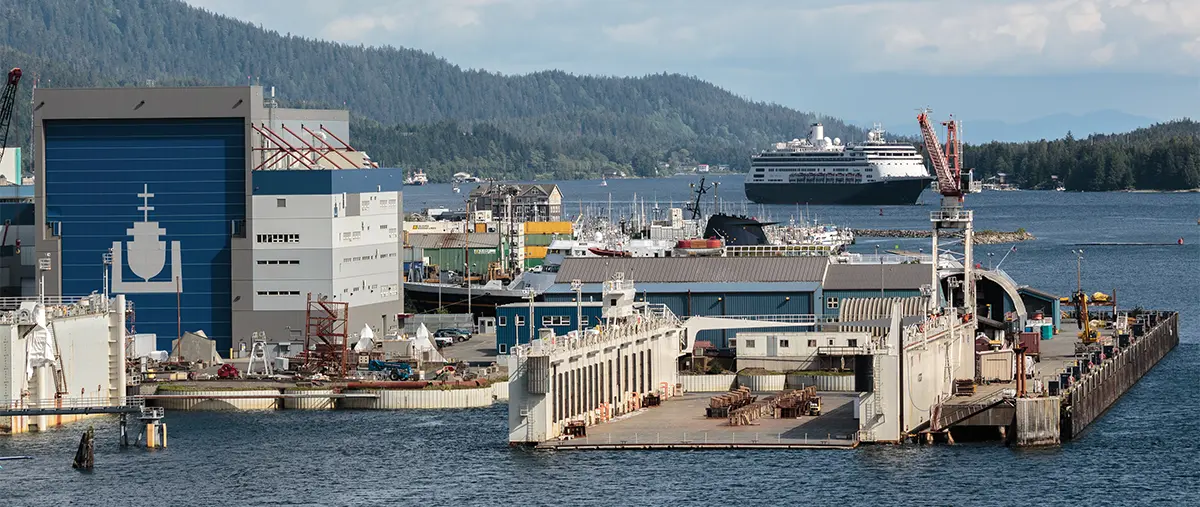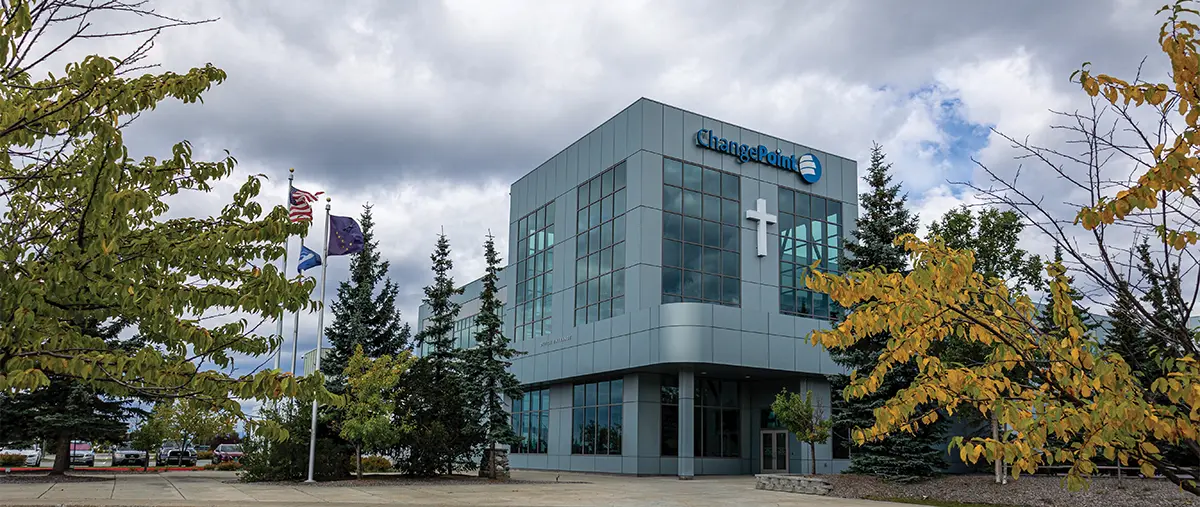cribbles marred the faces of officials most Alaskans wouldn’t recognize. On flyers that arrived in mailboxes this spring, Alaska Industrial Development and Export Authority (AIDEA) board members were shown as a pirate, a clown, a pig, a chicken, and a devil. The only female board member was depicted as a fanged troll while, in a gesture toward gender sensitivity, the guise of a warty witch was applied to her male colleague.
What had they done to deserve such treatment? According to the flyers, the AIDEA board members are “losers” because, under their watch, “Alaska lost out on $10 billion.”
AIDEA has been in the crosshairs before. For decades, its most notorious failed investments have been talking points for small-government conservatives opposed to state intervention in the free market. The flyer, though, is not conservative handiwork; it is sponsored by the 907 Initiative, which spent the last couple of years making sure Anchorage voters were aware of Mayor Dave Bronson’s every shortcoming, until he lost re-election in May.
After the campaign against Bronson, 907 Initiative could’ve picked any number of targets. Executive Director Aubrey Wieber set his sights on AIDEA. “AIDEA has long been a pretty egregious example of government waste and mismanagement, so that was always on my list,” he says. “Most people don’t know what it means or what AIDEA really does.”
Appointed by the governor and confirmed by the legislature, they meet every month or two to guide AIDEA staff in the management of the authority’s resources in fulfillment of its statutory purpose: to promote, develop, and advance the general prosperity and economic welfare of the people of the state, with particular attention to creating jobs.
Although board appointments are political positions, the members are not politicians, by and large. Fogle ran for Alaska House in 2018, and Kendig is a longtime member of the Knik-Fairview Community Council, but these figures aren’t the typical targets of attack ads.
Wieber, who spent most of his career in journalism, including a year as a political reporter for the Anchorage Daily News, admits the graphics are a bit aggressive, but the point is to catch the eye. “There isn’t an interest in personal attacks on anybody,” he says. “I think it’s important that our ads grab attention to ultimately have an effect.”
Wieber’s name is on the flyers approving the message. “It was super important that everything we did was factual and was cited,” he says. “We come at things with a perspective. I certainly don’t try and hide that.”
The campaign coincided with a legislative attempt to increase AIDEA’s bonding authority, allowing the board to approve debt financing greater than $25 million. In March, a bill to raise the Alaska Railroad Corporation’s bonding authority gained an amendment to let AIDEA sell bonds up to $300 million for infrastructure related to critical mineral development.
In Wieber’s view, “That’s pretty egregious as well, and I just felt like people needed to know that.”
By May, the amendment was stripped out, and the governor ended up vetoing the railroad bonding bill on constitutional grounds. However, bonding authority was hardly the only bone of contention.
Merely invoking the names of those gambles can elicit groans. Alaska Seafood International, a $125 million venture in value-added manufacturing, sold for $25 million in 2002 to a church. Healy Clean Coal, a $350 million power plant built in 1998, sold for $50 million in 2012 to Golden Valley Electric Association and is now slated for shutdown.
“If you talk to people in state government, yes, they’re aware of it,” says Wieber. “But the problem is the public doesn’t know about it.”
The 907 Initiative cites a couple of other flops. It notes the $6.9 million invested in the Seward Coal Terminal, a blue steel dragon looming over Resurrection Bay. Idle since 2016, the Alaska Railroad started contracting this year for its demolition. Another example is AIDEA’s $94 million investment in a road, gravel pad, and production facility for the Mustang oil field on the North Slope. Part of the Southern Miluveach Unit west of ConocoPhillips Alaska’s Kuparuk River Unit, the field was in production for one month in 2019; AIDEA sold its interests earlier this year to Finnex Operating.
For a total tally of AIDEA’s win/loss record, Wieber’s main source is the 2022 report AIDEA Cost and Financial Performance: A Long, Hard Look by Milt Barker and Gregg Erickson, with additional information from Alaska Megaprojects Update by Ginny Fay. Among its key findings: “Of the $682 million AIDEA invested in subsidizing projects since 1987, $294 million has been written-off as worthless by AIDEA’s board.”
Thus, the authors calculate: “Since 1980, AIDEA has received a net $301 million of public funds to subsidize economic development. Had those funds been appropriated to and their earnings retained in the Alaska Permanent Fund, the State savings account would be richer by $11.4 billion.”
Subtracting AIDEA’s current net worth of $1.4 billion yields the $10 billion that critics say Alaskans have lost, compared to investing in the Permanent Fund.
Ruaro suggests looking at the statutory language when legislators created each endowment. “For the Permanent Fund, it’s a monetary return on royalties and funds earned from oil and gas development of Alaska’s resources. For AIDEA, they were very clear that the main concern was to create jobs, especially in rural Alaska,” he says.
Economic development is a service, like public transit or postal delivery, which sometimes loses money for the greater good.
As an example, when AIDEA acquired the Snettisham Hydroelectric Project in 1998 from the federal government for $100 million, the goal was to ensure reliable, low-cost power for Juneau. The operator, Alaska Electric Light & Power, has an agreement to buy the whole works for $1 in about a decade, when AIDEA’s bonds are paid off. The capital city will continue to benefit from cheap, renewable energy.
Meanwhile, decarbonization of energy halted exports from the Seward Coal Terminal. Japan, South Korea, and Chile stopped buying Alaska coal because of global market conditions. Global energy markets likewise torpedoed the Mustang project, when oil prices dipped in 2020 during the COVID-19 pandemic.
Ruaro believes AIDEA can’t be blamed in some other cases. “Sometimes it’s not an AIDEA-initiated effort that doesn’t work out. Sometimes it’s ‘we want you to do this,’ and it doesn’t work out,” he says, citing Healy Clean Coal, begun as a federally funded demonstration project.
As Ruaro puts it, “It’s not always just us making an error.”
Even the 126-page Long, Hard Look has no complaints about AIDEA-owned assets such as the Ketchikan Shipyard, the Interior Energy Project, the FedEx Aircraft Maintenance Facility in Anchorage, or the Camp Denali Readiness Center at Joint Base Elmendorf-Richardson.
Barker and Erickson do express reservations about the DeLong Mountain Transportation System, the access road and shipping facilities for Red Dog Mine, but not because it’s a failure. The toll road is one of AIDEA’s crowning achievements. “It’s been extremely successful,” says Ruaro. “I think AIDEA is about to hit $1 billion in payments for that project.” Not to mention the local hire and mineral wealth since the world’s largest zinc mine began operating in 1989.
Barker and Erickson contend that someone else would’ve built a road for Red Dog Mine, so AIDEA doesn’t deserve credit.
Apart from megaprojects, Ruaro is most proud of AIDEA’s support for small businesses, mainly through its loan participation program (LPP). AIDEA buys up to 90 percent of a commercial loan from a bank and offers the borrower better terms than the private-sector lender.
A supplemental report in March by Barker and Erickson counts $417 million spent on LPP from 2008 to 2023. The authors say, “For the most part, LPP borrowers are legal entities you’ve never heard of, created for tax, legal, or business organizational purposes.” They accuse AIDEA of overestimating the jobs created by LPP. The report estimates fifteen full-time equivalent jobs created per year; AIDEA’s Loan Dashboard counts permanent jobs through LPP at ten or twenty times that amount.
Wieber acknowledges that the campaign accentuates the losses in AIDEA’s ledger. “Yes, we’re looking at a handful of projects,” he says. “We’re highlighting this bad return on investment, and that’s not something that they can run from.”
bullsiphoto | iStock

Patricia Morales | Alaska Business

Halting WSAR is a stated goal of SalmonState, the Juneau-based nonprofit that commissioned the Barker and Erickson reports that Wieber quotes in his 907 Initiative campaign. SalmonState opposes old-growth logging in the Tongass National Forest, bycatch by ocean trawlers, and the proposed Pebble gold mine. But WSAR is where AIDEA directly clashes against SalmonState’s environmental agenda.
Environmentalism is not why 907 Initiative criticizes AIDEA, according to Wieber. “We’re not an environmental organization. We’re looking at this through a good-governance lens,” he says. “I think it’s interesting that there is kind of a swell of organizations doing this at the same time, and it’s not coordinated with us. I don’t know about the environmental folks, but I think that speaks to kind of the need.”
Coordination or not, Ruaro sees a unified opposition. “The far left is committed to an agenda of stopping development in Alaska of any kind,” he says. “Frankly, in my view, that’s a business model on their side. A lot of these NGOs [non-governmental organizations] will interview with large trusts for funding to stop things in Alaska. It’s unfortunate, but it’s become a bit of a business model for them, I believe.”
SalmonState, for instance, is sponsored by the New Venture Fund, managed by Arabella Advisors. While New Venture Fund makes no secret of its ties to SalmonState and other left-leaning activist groups, it does not have to disclose sources of its funding as a 501(c)(4) nonprofit.
Nor does 907 Initiative. In general terms, Wieber says, “We receive grants from philanthropic organizations, and we also receive donations from individuals. We currently have an individual texting fundraising program going right now and receive probably about ten donations a day from Alaskans that are just receiving this text. They’ve seen our work and our supporting it.”
Wieber calls AIDEA’s focus on its critics’ financial backers a deflection from the authority’s own evasions of transparency and a straw man argument. “Our communications speak for themselves. We’re not trying to hide what we’re doing,” he says. “We send out press releases, and we set up web pages with information; the ‘paid for by’ has my name on it. I think we’re being pretty transparent about who’s making the decisions here.”
He revealed no hint as to 907 Initiative’s next target, if any. Fundraising is Wieber’s main job right now. “I know that people think that the money is easy to get,” he says. “It’s not. You have to work pretty hard at it, actually.”
What did the money spent opposing AIDEA ultimately achieve? The bond limit wasn’t raised to $300 million, so that’s something. WSAR remains an issue where Alaskans may express their will through democratic and bureaucratic processes. And scrutiny of AIDEA’s policies and practices might result in governance changes.
Ruaro says, “We’re constantly trying to improve. If there’s reasonable suggestions, we’re open to hearing those. But what we’ve seen a lot of so far is an effort to keep AIDEA from developing Alaska’s resources, which is what the state is supposed to do.”
If there’s one area of agreement, it’s that the public ought to learn more about AIDEA.
“We’re going to be increasing our communications efforts. We’re going to try to get facts out to people,” says Ruaro. “One of the most important parts of the effort of pushing back is to not get bogged down in a back and forth with SalmonState but to show Alaskans who our clients are: all the mom and pops, small businesses to large businesses. That’s who AIDEA is.”